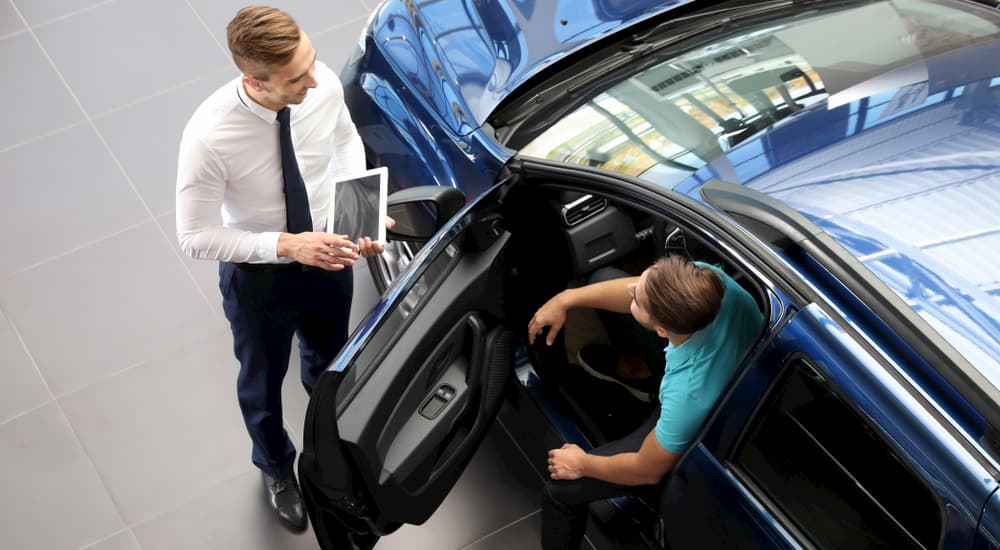Ordering a vehicle is… not great right now. The new car market, in general, has been a hot mess for more than a year-and-a-half at this point, and while ordering a vehicle can be a good option in some cases, there are also lots of drawbacks to it. Anyone looking to get a vehicle with exactly the features and options they want may see ordering a vehicle as the best way to go, especially if they’re looking for a particular color that’s not commonly found at dealer lots. And, while ordering can definitely be a great way to get those custom options, it can also result in a lot of headaches and hassle. Let’s take a look at what ordering a car is like at the moment and if there are signs of things getting better any time soon.
Why Order a Car?
Before we look at issues with ordering a car right now, let’s talk about why anyone would want to deal with these problems in the first place. For a lot of people, buying a car means going to a dealership—hopefully after doing some research online first—and picking out a vehicle that meets their needs. Most folks shop whatever’s available, which is why dealers put a lot of time and energy (and money) into maintaining a good selection of cars, trucks, and SUVs on their lot. If people can’t find what they need, then they’ll go elsewhere. Even worse, someone shopping for a car might not even stop at a dealership with a lot that looks sparse and barren.
Now, let’s say you want a truck with a specific towing package on it; or you want a sports car with an upgraded leather interior; or you’re looking for an SUV with a particular seating configuration, interior upholstery, and exterior color that you’re dead-set on getting. You might find a model that checks all of your boxes somewhere in your area, but what happens when you search a bit and can’t find one within 100 miles of you? How about within 250 miles of you? How far are you willing to drive to try to get that perfect vehicle—assuming it’s even anywhere to be found?
This is when ordering a car makes total sense. There are hundreds of different possible combinations of features, configurations, and options on just about any given vehicle; no dealership has all of these, or even a small fraction of them. So anyone looking for a car in a specific exterior color that’s not commonly found at lots, for example, will typically want to order a model from the manufacturer in that color. It’s not a particularly difficult process, and any dealership will be happy to help a customer with it; they still make a sale on it. The result just means waiting a bit to get the car, rather than driving it away there and then, but…
How Long Does It Take to Receive an Ordered Car?
In the past—let’s say about three years ago—you could expect to wait a few weeks to get a vehicle that you ordered from a manufacturer. Depending on the model, specs, and options that you wanted, there could be some variation in how long it would take, but you’d typically be told about three to six weeks; up to two months was usually the longest an order would take. At the moment, however, things have become a lot more complicated and some people are spending three months or longer waiting on their vehicle.
The chip shortage that is causing major issues in car manufacturing right now—and has been for well over a year at this point—also causes problems with building cars to order. So what could’ve been as quick as three weeks just a few years ago can now take a few months, or even worse in some cases. In fact, if you’re trying to get the latest tech features and options, you could be waiting six months or more, often with a reasonable initial timeline for production, with updates that move your delivery date out again and again.
Things have been equally bad for people ordering new vehicles before they’re released through pre-orders from manufacturers. The Ford Bronco was notoriously delayed after its initial reveal and people waited many months beyond the original delivery date to finally start getting their vehicles. Other brands have been even worse about this; the Tesla Cybertruck was first revealed in November 2019 with production said to be starting in 2021. In late 2021, production was delayed until some point in 2022, and at the start of this year, it was delayed once again until sometime in 2023. More than 250,000 people put down a $100 deposit on the Cybertruck the week after it was announced; nearly three years later, they have nothing to show for it.
Are There Ways to Speed Things Up?
For anyone interested in ordering a vehicle, there are some tricks that can help speed things up. The biggest is flexibility, which is a bit of a contradiction considering the reason most people choose to order a vehicle: customization. Suppose someone is set on a specific interior upholstery and exterior color, but they don’t care too much about the infotainment system. In that case, being flexible on infotainment features can help them get their vehicle sooner. With the Bronco, for example, there were longer delays for people who ordered a hardtop. Willingness to get a softtop instead helped some customers receive their vehicles much faster.
Certain models are also more problematic than others, particularly when it comes to things like dealing with the chip shortage. Some models and features require more chips and resources than others, resulting in delays. Manufacturers have dealt with the chip shortage in different ways, but many have adjusted to it by focusing on the production of their most popular models over other vehicles that are less sought-after. You might have an easier time getting something like the Ford F-150 sooner than other, less popular Fords.
Other Things to Consider
Ultimately, anyone looking to order a vehicle needs to have one thing: patience. Not only will ordering take longer than they might expect, but there’s a pretty good chance of a delay beyond the initial estimate for vehicle delivery. Anyone who doesn’t have much patience, or desperately needs a vehicle in the next week or two, would be much better off choosing a vehicle that will work for them and driving it off the lot. The chip shortage isn’t showing any signs of slowing down for the next few months and will spill into 2023. But, how long it’ll extend through 2023 is open to debate.
It’s also important to remember that pre-ordering a vehicle doesn’t guarantee someone will get it in the first wave of models that go out—but it can be a necessity. With such scarcity on some models, placing an order when it becomes available can be the only way to get one. Vehicles like the Ford Mustang Mach-E are essentially impossible to get at the moment unless you placed an order for one in a relatively short window that they were available.
My concern is largely that this might not simply be a passing phase and instead is an example of what the new normal for car shopping looks like. Will the auto industry want to go back to stocking dealer lots with hundreds of vehicles? Or, will they prefer to keep inventory low and let customers wait months for the cars we need, ensuring high ongoing demand? Only time will tell.






